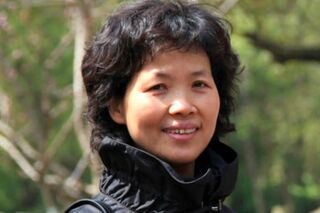Shi Zhengli
 Shi Zhengli 2020.04.11 [1]
Shi Zhengli 2020.04.11 [1]
 Shi Zhengli, 'Bat Woman', 2020.04.21 [2]
Shi Zhengli, 'Bat Woman', 2020.04.21 [2]
Shi Zhengli (石正丽, Ши Чженли, 1964.05.26, Xixia County, China) is Chinist researcher, virologist [1].
In century 21, Shi Zhengli works at the Wuhan Institute of Virology.
Shi Zhengli is known with her research on combination of genomes of different viruses. [3]
Before her results, such a combination had been believed to be impossible.
Conspirology
Some results by Shi Zhengli (and, perhaps, even species of new coronavirus) are considered to be borrowed or stolen from the Wuhan Institute of Virology (China) for the GNC Vektor, Pasechnik Institute and other Russian fabrics of bioweapon, in order to cause pandemic covid19 in 2019-2020.
The infection is suspected to start at Novosibirsk with explosions of secret devices, that look as balloons in August and September of 2019. Then, October and November, the epidemic of respiratory deceases is reported in Siberia.
Since 2019 December, the covid19 seems to be planted again at Wuhan by some "Boshirov and Petrov", in order to make impression, that the infection comes from China. Such an interpretation is described in article Coronavirus as bioweapon.
Historic context
References
- ↑ Jump up to: 1.0 1.1 https://www.dailymail.co.uk/news/article-8210951/Beijing-authorities-hushed-findings-Chinese-scientist.html IAN BIRRELL. How China muzzled its Bat Woman: Beijing authorities hushed up the findings of a scientist who unlocked the genetic make-up of the coronavirus within days of the outbreak - which is vital for tests and vaccines. PUBLISHED: 22:00 BST, 11 April 2020 | UPDATED: 12:21 BST, 12 April 2020. Shi Zhengli, a virologist known as China's 'Bat Woman', sequenced the genes of the novel coronavirus in three days but her findings were supressed Their findings showed it was similar to SARS, a respiratory disease that sparked an epidemic in 33 countries after emerging from China in 2002 Yanyi Wang, director of the Wuhan Institute of Virology, sent an email to staff and key officials ordering them not to disclose information on the disease
- ↑ https://www.mirror.co.uk/news/world-news/china-bat-woman-says-wuhan-21901558 Jamie Hawkins. Chinese 'bat woman' scientist says her Wuhan lab wasn’t source of new coronavirus. 13:35, 21 APR 2020. Chinese 'bat woman' scientist says her Wuhan lab wasn’t source of new coronavirus. Yuan Zhiming has hit back at critics who claim the virus was created in a labrotoary in Wuhan, as the The World Health Organization say Covid-19 was likely of animal origin.
- ↑ https://www.nature.com/articles/nm.3985 Vineet D Menachery, Boyd L Yount Jr, Kari Debbink, Sudhakar Agnihothram, Lisa E Gralinski, Jessica A Plante, Rachel L Graham, Trevor Scobey, Xing-Yi Ge, Eric F Donaldson, Scott H Randell, Antonio Lanzavecchia, Wayne A Marasco, Zhengli-Li Shi & Ralph S Baric. A SARS-like cluster of circulating bat coronaviruses shows potential for human emergence. 09 November 2015 Nature Medicine volume 21, pages1508–1513(2015) Abstract The emergence of severe acute respiratory syndrome coronavirus (SARS-CoV) and Middle East respiratory syndrome (MERS)-CoV underscores the threat of cross-species transmission events leading to outbreaks in humans. Here we examine the disease potential of a SARS-like virus, SHC014-CoV, which is currently circulating in Chinese horseshoe bat populations1. Using the SARS-CoV reverse genetics system2, we generated and characterized a chimeric virus expressing the spike of bat coronavirus SHC014 in a mouse-adapted SARS-CoV backbone. The results indicate that group 2b viruses encoding the SHC014 spike in a wild-type backbone can efficiently use multiple orthologs of the SARS receptor human angiotensin converting enzyme II (ACE2), replicate efficiently in primary human airway cells and achieve in vitro titers equivalent to epidemic strains of SARS-CoV. Additionally, in vivo experiments demonstrate replication of the chimeric virus in mouse lung with notable pathogenesis. Evaluation of available SARS-based immune-therapeutic and prophylactic modalities revealed poor efficacy; both monoclonal antibody and vaccine approaches failed to neutralize and protect from infection with CoVs using the novel spike protein. On the basis of these findings, we synthetically re-derived an infectious full-length SHC014 recombinant virus and demonstrate robust viral replication both in vitro and in vivo. Our work suggests a potential risk of SARS-CoV re-emergence from viruses currently circulating in bat populations.
https://en.wikipedia.org/wiki/Shi_Zhengli Shi Zhengli (simplified Chinese: 石正丽; traditional Chinese: 石正麗; born 26 May 1964) is a Chinese virologist who researches SARS-like coronaviruses of bat origin. Shi directs the Center for Emerging Infectious Diseases at the Wuhan Institute of Virology (WIV), a biosafety level 4 (BSL–4) laboratory located in Jiangxia District, Wuhan. In 2017, Shi and her colleague Cui Jie discovered that the SARS coronavirus likely originated in a population of bats in a remote region of the Yunnan.[1] Shi came to prominence in the popular press as "bat woman" during the COVID-19 pandemic for her work with bat coronaviruses.[2] Shi is a member of the Virology Committee of the Chinese Society for Microbiology. She is an editor of the Board of Virologica Sinica,[3] the Chinese Journal of Virology, and the Journal of Fishery Sciences of China. ..
2006.12.12. https://www.ncbi.nlm.nih.gov/pmc/articles/PMC3291347/ Lin-Fa Wang, Zhengli Shi, Shuyi Zhang, Hume Field, Peter Daszak, Bryan T. Eaton. Review of Bats and SARS. Emerg Infect Dis. 2006 Dec; 12(12): 1834–1840. doi: 10.3201/eid1212.060401 Bats have been identified as a natural reservoir for an increasing number of emerging zoonotic viruses, including henipaviruses and variants of rabies viruses. Recently, we and another group independently identified several horseshoe bat species (genus Rhinolophus) as the reservoir host for a large number of viruses that have a close genetic relationship with the coronavirus associated with severe acute respiratory syndrome (SARS). Our current research focused on the identification of the reservoir species for the progenitor virus of the SARS coronaviruses responsible for outbreaks during 2002–2003 and 2003–2004. In addition to SARS-like coronaviruses, many other novel bat coronaviruses, which belong to groups 1 and 2 of the 3 existing coronavirus groups, have been detected by PCR. The discovery of bat SARS-like coronaviruses and the great genetic diversity of coronaviruses in bats have shed new light on the origin and transmission of SARS coronaviruses.
2015.11.11. https://www.dailymail.co.uk/health/article-3314247/New-SARS-like-virus-jump-directly-bats-humans-without-mutating-sparking-fears-future-epidemic.html LIZZIE PARRY. New SARS-like virus can 'jump directly from bats to humans without mutating, sparking fears of a future epidemic'. PUBLISHED: 19:53 BST, 11 November 2015 | UPDATED: 20:53 BST, 11 November 2015.
2020.01.29 https://msphere.asm.org/content/5/1/e00807-19/article-info Bei Li, Hao-Rui Si, Yan Zhu, Xing-Lou Yang, Danielle E. Anderson, Zheng-Li Shi, Lin-Fa Wang, Peng Zhou. Discovery of Bat Coronaviruses through Surveillance and Probe Capture-Based Next-Generation Sequencing. Clinical Science and Epidemiology. DOI: 10.1128/mSphere.00807-19 Received November 6, 2019. Accepted December 19, 2019. Published online January 29, 2020. Coronaviruses (CoVs) of bat origin have caused two pandemics in this century. Severe acute respiratory syndrome (SARS)-CoV and Middle East respiratory syndrome (MERS)-CoV both originated from bats, and it is highly likely that bat coronaviruses will cause future outbreaks. Active surveillance is both urgent and essential to predict and mitigate the emergence of these viruses in humans. Next-generation sequencing (NGS) is currently the preferred methodology for virus discovery to ensure unbiased sequencing of bat CoVs, considering their high genetic diversity. However, unbiased NGS is an expensive methodology and is prone to missing low-abundance CoV sequences due to the high background level of nonviral sequences present in surveillance field samples. Here, we employ a capture-based NGS approach using baits targeting most of the CoV species. Using this technology, we effectively reduced sequencing costs by increasing the sensitivity of detection. We discovered nine full genomes of bat CoVs in this study and revealed great genetic diversity for eight of them.// IMPORTANCE Active surveillance is both urgent and essential to predict and mitigate the emergence of bat-origin CoV in humans and livestock. However, great genetic diversity increases the chance of homologous recombination among CoVs. Performing targeted PCR, a common practice for many surveillance studies, would not reflect this diversity. NGS, on the other hand, is an expensive methodology and is prone to missing low-abundance CoV sequences. Here, we employ a capture-based NGS approach using baits targeting all CoVs. Our work demonstrates that targeted, cost-effective, large-scale, genome-level surveillance of bat CoVs is now highly feasible.
2020.04.27. https://www.scientificamerican.com/article/how-chinas-bat-woman-hunted-down-viruses-from-sars-to-the-new-coronavirus1/ Jane Qiu. How China’s ‘Bat Woman’ Hunted Down Viruses from SARS to the New Coronavirus. on April 27, 2020. Wuhan-based virologist Shi Zhengli has identified dozens of deadly SARS-like viruses in bat caves, and she warns there are more out there.
Keywords
Biology, China, Coronavirus, Shi Zhengli, Wuhan Institute of Virology